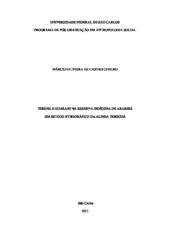| dc.contributor.author | Coelho, Márcio Oliveira de Castro | |
| dc.date.accessioned | 2017-04-19T14:31:44Z | |
| dc.date.available | 2017-04-19T14:31:44Z | |
| dc.date.issued | 2016-09-06 | |
| dc.identifier.citation | COELHO, Márcio Oliveira de Castro. Terena e Guarani na reserva indígena de Araribá: um estudo etnográfico da aldeia Tereguá. 2016. Dissertação (Mestrado em Antropologia Social) – Universidade Federal de São Carlos, São Carlos, 2016. Disponível em: https://repositorio.ufscar.br/handle/ufscar/8633. | * |
| dc.identifier.uri | https://repositorio.ufscar.br/handle/ufscar/8633 | |
| dc.description.abstract | This dissertation is analytically the historical formation of the Indian Reserve Araribá
located in the municipality of Avai (SP), focusing on the relationships that occur
between Terena and Guarani groups that will lead to the formation of a village called
Tereguá where, theoretically, individuals inhabit the mixing occurred between these
ethnic groups. The reserve Araribá was created in 1913 by the official indigenous
agency of the Brazilian state, first the Indian Protection Service - SPI (1910-1967) and
then the National Indian Foundation - FUNAI (1967 onwards), on land belonging to the
unoccupied calls state of São Paulo in territorialization process of the Guarani
indigenous population that was scattered between the São Paulo west, north of Parana
and east of Mato Grosso do Sul. Araribá reserve, initially occupied by Guarani families,
eventually adding Terena families brought by SPI, from the 1930s, from Mato Grosso
(South), and Brazilian regional were also incorporated by intermarriage. Currently, the
reserve of 1.930 hectares, with a population of about 600 people, is divided into four
villages: Kopenoti and Ekeruá occupied by Terena families; Nimuendajú occupied by
families Guarani and Terena Tereguá occupied by families, Guarani and those in which
there was a mix between these two ethnic groups. The sources used are literature and
ethnographic, from a participant observation and conversations with the Indians during
the research field. The work seeks to make an ethnography of Tereguá community,
highlighting its historical formation and their relationships, established inside the
reserve, with the other villages. | eng |
| dc.description.sponsorship | Coordenação de Aperfeiçoamento de Pessoal de Nível Superior (CAPES) | por |
| dc.language.iso | por | por |
| dc.publisher | Universidade Federal de São Carlos | por |
| dc.rights.uri | Acesso aberto | por |
| dc.subject | Reserva indígena de Araribá | por |
| dc.subject | Aldeia Tereguá | por |
| dc.subject | Mistura | por |
| dc.subject | Socialidade | por |
| dc.subject | Indian reservation Araribá | eng |
| dc.subject | Tereguá village | eng |
| dc.subject | Mixture | eng |
| dc.subject | Sociality | eng |
| dc.title | Terena e Guarani na reserva indígena de Araribá: um estudo etnográfico da aldeia Tereguá | por |
| dc.type | Dissertação | por |
| dc.contributor.advisor1 | Peggion, Edmundo Antonio | |
| dc.contributor.advisor1Lattes | http://lattes.cnpq.br/9849805103860827 | por |
| dc.description.resumo | Essa dissertação tem como base analítica a formação histórica da Reserva Indígena
Araribá, localizada no município de Avaí (SP), focando nas relações ocorridas entre os
grupos Terena e Guarani, que vão dar origem à formação de uma aldeia denominada
Tereguá, onde, teoricamente, habitariam os indivíduos resultantes da mistura ocorrida
entre esses grupos étnicos. A reserva de Araribá foi criada em 1913 pelo órgão
indigenista oficial do Estado brasileiro, primeiramente Serviço de Proteção aos Índios -
SPI (1910-1967) e depois a Fundação Nacional do Índio - FUNAI (1967 em diante), em
terras chamadas devolutas pertencentes ao estado de São Paulo num processo de
territorialização da população indígena Guarani que se encontrava dispersa entre o oeste
paulista, norte do Paraná e leste de Mato Grosso do Sul. A reserva Araribá, inicialmente
ocupada por famílias Guarani, acabou agregando famílias Terena trazidas pelo SPI, a
partir dos anos 1930, de Mato Grosso (do Sul), sendo que regionais brasileiros também
foram incorporados por casamentos interétnicos. Atualmente, a reserva de 1.930
hectares, com uma população de cerca de 600 pessoas, está dividida em quatro aldeias:
Kopenoti e Ekeruá ocupadas por famílias Terena; Nimuendajú ocupada por famílias
Guarani e Tereguá ocupada por famílias Terena, Guarani e aquelas nas quais ocorreu a
mistura entre esses dois grupo étnicos. As fontes utilizadas são bibliográficas e
etnográficas, a partir de uma observação participante e conversas com os indígenas
durante a pesquisa de campo. O trabalho procura fazer uma etnografia da comunidade
Tereguá, destacando sua formação histórica e suas relações, estabelecidas no interior da
reserva, com as outras aldeias. | por |
| dc.publisher.initials | UFSCar | por |
| dc.publisher.program | Programa de Pós-Graduação em Antropologia Social - PPGAS | por |
| dc.subject.cnpq | CIENCIAS HUMANAS::ANTROPOLOGIA | por |
| dc.ufscar.embargo | Online | por |
| dc.publisher.address | Câmpus São Carlos | por |
| dc.contributor.authorlattes | http://lattes.cnpq.br/9732373399062436 | por |
